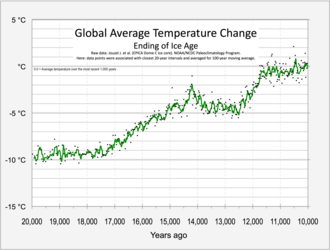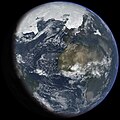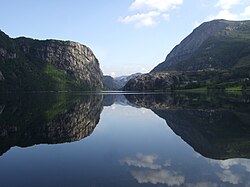Ice age

An ice age is a period that for a long time the temperature of Earth's climate is very low. That leads to an expansion of the continental ice sheets, polar ice sheets and mountain glaciers.
'Ice age' is a term used in palaeoclimatology for the period of extensive ice sheets in the recent Pleistocene period. We now know that ice ages have happened a number of times in the past, the greatest and longest of which took place in the Proterozoic era, before multicellular eukaryotes evolved.[1][2]
During ice ages, the sea level drops as water is held in the great ice sheets at the poles. How much it drops depends on several factors, such as the length of time that a cold period lasts.
Stages
Within an ice age, there are stages. The longer cold stages are called glacials or glacial periods. The shorter warm periods are called interglacials. The last glacial ended about 11,000 years ago, when the present interglacial started. The Greenland and Antarctic ice sheets still exist. The last two million years have been the Pleistocene ice age. During glacials, large and thick ice sheets covered much of North America and Eurasia.
Many glacial periods that have occurred during the last few million years are initially at 40,000-year frequency, but more recently ice ages have occurred at 100,000-year frequency.
This data come from a time that human beings had no large effect on the climate. Therefore, it is technically correct to say that humans had no effect on global climate in the Earth's history. However, in recent centuries they have burned much fossil fuel, which has partly been responsible for the present temperature rise.
Ice Age Media
An artist's impression of ice age Earth at Pleistocene glacial maximum
The Antarctic ice sheet. Ice sheets expand during an ice age.
Haukalivatnet lake (50 meters above sea level) where Jens Esmark in 1823 discovered similarities to moraines near existing glaciers in the high mountains
Ice age map of northern Germany and its northern neighbours. Red: maximum limit of Weichselian glacial; yellow: Saale glacial at maximum (Drenthe stage); blue: Elster glacial maximum glaciation.
Related pages
References
- ↑ Imbrie J. & Imbri, K.P. 1979. Ice ages: solving the mystery. Short Hills NJ: Enslow. ISBN 978-0-89490-015-0
- ↑ Alley R.B. 2000. The two-mile time machine: ice cores, abrupt climate change, and our future. Princeton University Press. ISBN 0-691-10296-1
Other websites
| Wikimedia Commons has media related to Lua error in Module:Commons_link at line 62: attempt to index field 'wikibase' (a nil value).. |
- Cracking the Ice Age from PBS
- Climate patterns[dead link]







